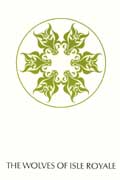.gif)
MENU
![]() Foreword
Foreword
Methods and Extent of Present Research
|
Fauna of the National Parks — No. 7
The Wolves of Isle Royale |

|
FOREWORD
THOUGHTFUL PEOPLE have advanced many reasons for setting aside samples of our various "wilderness" types to he reserved in a relatively undisturbed condition. One of the best is the possibility of using such lands and waters for research. The life communities of primitive times were durable and productive. We can learn much that applies in our resource husbandry by studying the mechanisms that worked so well in the green world of North America before the coming of the white man.
The principle is good, but a taxing problem today is finding those primordial communities of living things. Fortunately, some of the best we have are in the care of the National Park Service. This study of the wolf by David Mech (pronounced "meech") could have been made in only one area south of Canada—Isle Royale National Park.
The fact that this roadless wilderness is an island is fortunate too, for on islands you stand the best chance of making least-complicated counts of animals. Isle Royale is a range of goodly size for wolves and moose. And no one will forget that it is manned by that particular kind of professional outdoorsman you find on national park staffs. The logistic support for such a study was on hand.
These were important considerations when, in 1957, a cooperative agreement was entered into between Purdue University and the National Park Service for studies of the wolf and its prey on Isle Royale. It was to be a series of 3-year projects carried out by graduate students working for their Ph. D. A National Science Foundation grant was obtained as principal support; the next problem was to find a proper man for the initial study of wolf ecology.
I met David Mech, then a senior wildlife student at Cornell, in autumn of 1957, and looked no further. Dave, a native of Syracuse, was a highly recommended scholar and self-trained woodsman who spent Christmas vacations tracking fishers in the Adirondacks. For two summers he had worked on New York's bear study, including trapping, handling, and marking bruins of every description and temperament. He was hale and eager to learn about wolves.
The fieldwork began in June 1958, and after a fall semester of course work, Dave went to the island for the first 7-week winter period in February and March 1959. By further good fortune, that winter he met Donald E. Murray, of Mountain Iron, Minn., who was engaged as one of the aircraft pilots for the project that year. In the two succeeding winters, the team of Mech and Murray achieved great things in the aerial observation of wolves and their hunting. Don has continued to serve the Isle Royale studies each winter as a mainstay of the program.
David Mech submitted his thesis and received his doctoral degree in 1962. With some modifications, the thesis became this, the seventh in the National Parks Fauna series. It lays the groundwork for the continuing program that is necessary to gather significant information on such long-lived animals as wolves and moose Likewise, it has set a standard that will take some doing to maintain.
Some years ago, people seemed to have all the facts they needed on predator-prey relationships. But the assumptions are breaking down as scientific scrutiny reveals the time-tested adaptations through which wild creatures survive. This account of the great wild dog of North America and its largest antlered prey has something important to add.
DURWARD L. ALLEN
Professor of Wildlife Ecology
Purdue University
 Top
Top
Last Modified: Thurs, Jul 4 2002 10:00:00 pm PDT
http://www.cr.nps.gov/history/online_books/fauna7/fauna0a.htm
![]()
